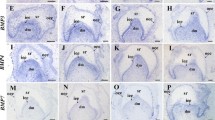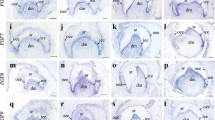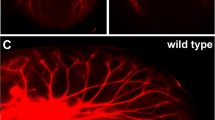Abstract
. Target-derived neurotrophins support and sustain peripheral sensory neurons during development. In addition, it has been suggested that these growth factors could have developmental functions in non-neuronal tissues. To further elucidate the possible roles of neurotrophins in tooth morphogenesis and innervation, we have used in-situ hybridization to determine the specific sites of neurotrophin gene activity in pre- and postnatal rat jaws from E16 to P7. All four neurotrophins were expressed during tooth development with specific temporospatial patterns. Nerve growth factor (NGF) and brain-derived neurotrophic factor (BDNF) mRNAs were mainly detected in the dental papilla/pulp in postnatal animals, and the pattern of expression correlated with the onset of dental innervation. In contrast, neurotrophin 3 (NT3) and neurotrophin 4 (NT4) mRNA expression patterns were predominantly epithelial and were strongest during early developmental stages when teeth are not yet innervated. Dental papilla NGF-mRNA expression was first seen in both epithelium and mesenchyme and later shifted to the odontoblast layer and the subodontoblast zone. BDNF-mRNA labeling was present in low levels in the early dental organ, but increased in the pulp and in the odontoblast cell layer of the developing teeth at later developmental stages. Both NT3 and NT4 mRNA were observed in the prenatal oral epithelium and the inner dental epithelium. NT3-mRNA labeling was seen mainly in the cervical loop region, fissure system depressions and cuspal tops, while NT4 mRNA was more evenly distributed in the dental epithelium. At P7, NT3-mRNA labeling was below detection level and NT4 mRNA expression was lower than at prior stages. Complementary to reports on the presence of low-affinity neurotrophin receptor (LANR), trkB and trkC mRNA in the developing teeth, our results suggest that neurotrophins may have multiple functions during tooth morphogenesis. Neurotrophins might participate in epithelial-mesenchymal interactions in early tooth morphogenetic events such as proliferation and differentiation of epithelial and mesenchymal cells. In addition, based on mRNA localization in postnatal animals, we also suggest that NGF and BDNF (beside glial cell line-derived neurotrophic factor) might participate in establishing and maintaining the innervation of the teeth, thus acting as classical neurotrophic factors.
Similar content being viewed by others
Author information
Authors and Affiliations
Additional information
Received: 5 May 1997 / Accepted: 22 May 1997
Rights and permissions
About this article
Cite this article
Nosrat, C., Fried, K., Lindskog, S. et al. Cellular expression of neurotrophin mRNAs during tooth development. Cell Tissue Res 290, 569–580 (1997). https://doi.org/10.1007/s004410050962
Issue Date:
DOI: https://doi.org/10.1007/s004410050962




